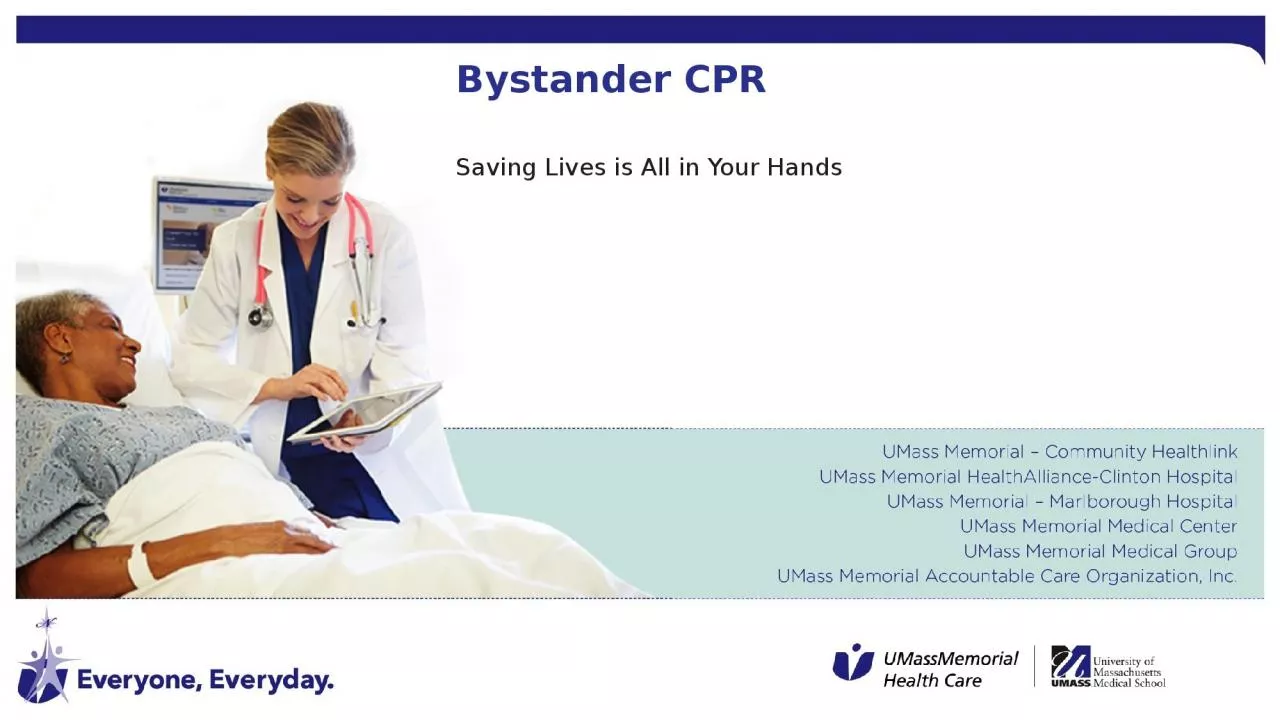

Objectives List the steps for performing handsonly cardiopulmonary resuscitation CPR Identify the compression rate range for performing effective CPR Explain the significance of the Good Samaritan law for bystanders who observe a person experiencing a cardiac arrest ID: 1041669
Download Presentation The PPT/PDF document "Bystander CPR Saving Lives is All in You..." is the property of its rightful owner. Permission is granted to download and print the materials on this web site for personal, non-commercial use only, and to display it on your personal computer provided you do not modify the materials and that you retain all copyright notices contained in the materials. By downloading content from our website, you accept the terms of this agreement.
1. Bystander CPRSaving Lives is All in Your Hands
2. ObjectivesList the steps for performing hands-only cardiopulmonary resuscitation (CPR).Identify the compression rate range for performing effective CPR.Explain the significance of the Good Samaritan law for bystanders who observe a person experiencing a cardiac arrest.
3. Facts About Sudden Cardiac ArrestLeading cause of deathUsually occurs at homeVictims often over age 50More than 400 deaths in Worcester County each yearSurvivors are among those who receive bystander CPR
4. Bystanders and CPRFor victims of a cardiac arrest that is observed by bystanders:Two out of three victims don’t receive bystander CPR before emergency medical services (EMS) arrive.This greatly reduces their chances of survival.Hands-only CPR is easier to perform than traditional CPR, is effective and may lead to more bystander CPR helping victims.The only bad CPR is no CPR.
5. Steps for How to PerformWhen someone collapses and seems lifeless:Call 911, place phone on speaker mode to leave your hands free.Check responsiveness of the victim.Ask if there is a defibrillator nearby. Place the victim on a flat surface if possible.Perform hands-only CPR.
6. Step 1-Call 911When someone collapses, act as quickly as possible.When using a cellphone, place it on speaker mode if possible.911 operators can help guide you through performing CPR and keep you posted on when help will arrive.
7. Step 2-Check ResponsivenessCheck ResponsivenessGently shake the victim and ask if he/she is OK.If the victim isn’t breathing, start CPR.Many victims will continue breathing, but are unresponsive and their breathing is abnormal.If the victim is unresponsive and not breathing, or breathing abnormally, start CPR.
8. Step 3- Ask About a DefibrillatorAsk if there’s a defibrillator nearby and use it if necessary.Automatic external defibrillators (AEDs) are devices that can help restart a cardiac arrest victim’s heart if applied after collapse.AEDs are located in many businesses, malls, airports, casinos and hospitals.These devices will guide untrained bystanders how to use the AED each step of the way.The AED will analyze the heart rhythm and guide the bystander to shock the victim if appropriate.The device also will help guide the bystander in performing CPR.
9. Step 4-Place Victim on Flat, Hard SurfacePlace the victim on a hard, flat surface if possible.CPR is more effective if the victim is on a flat or hard surface.It’s easier to give bystander CPR if kneeling at the victims side.
10. Step 5-Perform Hands-Only CPRStart Hands-only CPRIn CPR, you compress the victims heart, which helps blood circulate to the vital organs and keeps the victim alive until his/her heart can be restarted.CPR is done in the center of the chest between the nipples.With both hands, compress down two inches and release at a rate of 100 to 120 times per minute.Too slow doesn’t pump enough blood.Too fast doesn’t allow the heart to fill with enough blood.Two inches is enough to squeeze the blood out for circulation. Once you have pressed down two inches, release pressure fully and compress again.You can use the song “Staying Alive” if you know it to time your compressions.
11. Saving LivesIf we can increase bystander CPR so that all victims receive CPR when they suffer a cardiac arrest, we will save 50 or more lives each year.Hands-only CPR is very effective.The only bad CPR is no CPR.
12. Good Samaritan LawsMassachusetts and most states have Good Samaritan laws that protect and encourage bystanders to provide CPR and to use a defibrillator to save lives
13. Review of Steps for RespondingWhen someone collapses and seems lifeless:Call 911, place phone on speaker mode to leave your hands free.Check responsiveness of the victim.Ask if there is a defibrillator nearby. Place the victim on a flat surface if possible.Perform hands-only CPR.